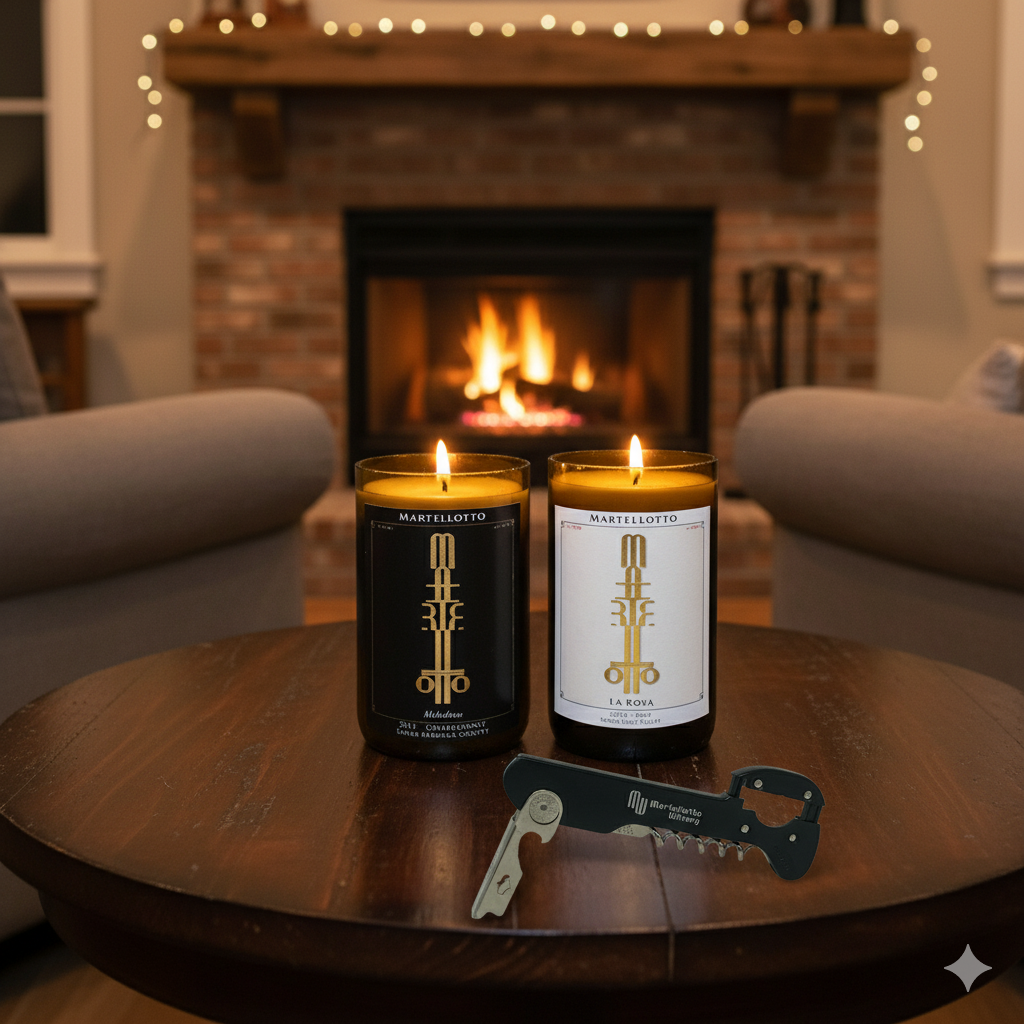How Should I Store My Wine?
The ideal conditions for storing wine mimic conditions in a subterranean winery cellar. Wine is made from fermented grapes and although it is stabilized and has sulfur as a preservative in it, it is still a fragile fruit. Variable temperatures (both high and low), light, and dry air can damage your precious wine. Proper cellar temperature is consistent and regulated between 54-59 °F. Proper humidity is important too, and this is typically between 50-70% relative humidity. The high humidity and cool temperate provides for proper long-term aging of wine in a cool, dark, damp environment. The reason most wine is bottled in a green or dark colored bottle is to protect the wine from light. Do not leave your wine in a place where it is exposed to sunlight. If you own or store wine worth more than $1000 or if you live in a hot, tropical climate, we recommend you purchase a wine refrigerator tout suite. Short-term storage options include a cool, dark closet or cabinet. Wine should not be kept in a refrigerator for more than a few months because it is too cold and does not provide for a humid environment.
How Long Can I Store Wine?
Our motto: wine is intended to be drunk and shared. There will always be more wine to purchase in the future. In general, you don’t need to stockpile wine, especially now that it is so easy to hop online and order wine to be delivered to your door within a few days, or even hours.
The truth is, 95% of all wines are not intended to be stored longer than five years. Most wines are produced to be drunk within a narrow window. Only exceptional (top 3%) dry white wines improve after five years. Virtually no Rosé wine will improve after three or four years of aging. Almost every wine you could purchase at a grocery store is intended to be drunk within 1-5 years. The exceptions are a handful wines over $75/btl, including sweet wines and highly pedigreed wines with a track record of lasting many years. Notable wines that are worthy of long-term aging include: some Classified Bordeaux, some Port, Madeira, Sherry, other fortified or sweet wines including Sauternes, some Premier and Grand cru white and red Burgundy, some new world Cabernets and Chardonnays, some top Champagne, some Italian wines like Barolo, Brunello, Aglianico, and Sagrantino, a few Gran Reserva Spanish Rioja, and a few Rhone varietal red wines.
What's the Best Temperature for Serving Wine?
The bottle of wine you are pouring should be refrigerator cold for Whites, Rosé, and Bubbles. Standard refrigerators are set to 40 °F or below. If you touch a glass bottle that has been in your refrigerator for more than a day, that is the correct temperature for serving most wines. Remember, that as soon as you pour a glass of wine, it starts to warm up based on the ambient temperature and likely from your own hand holding the glass. Reds should be drunk at 55-65 °F and the bottle should be cool, not cold, to the touch. The wine should be cool and refreshing in the mouth. IMPORTANT: Room temperature IS NOT the correct temperature to serve wine, unless the ambient temperature is 55-59 °F, which it most likely is not. If the wine has been sitting at room temperature or if you just brought it from the store, put the bottle of wine in the refrigerator for 10-20 minutes (or 5-10 minutes in the freezer for whites) and set a timer to check!
Should I Be Worried About Sediment in My Wine?
Many wines are bottled unfiltered, which is considered a more natural and less processed way to bottle wine. All wines were bottled unfiltered before modern equipment and filters existed in the last fifty years. The most common sediments in wine are solids leftover from the fermentation process. These solids include grape skins, seeds, stems, and yeast. These are harmless, but they may taste like dirt, so don’t drink them. Some older, red wines dissociate over time and the color may fall lighten. This too is normal. The other common sediment you will find in white wines, in particular, are tartrates. This looks like crystals or rock sugar and is result of tartaric acid not dissolving in the wine. Often, these crystals form as a result of the wine not having been thoroughly cold stabilized and then undergoing temperature changes in transit to you. Lastly, some wines are poorly made, are bottled sweet, and or were not filtered properly. If the wine smells and tastes bad and has an unusually large amount of sediment in it; it may be a bad bottle.
Is Decanting Wine Necessary?
Decanting is a process to aerate a wine with oxygen. The idea is that pouring the wine into a larger vessel, it will interact with more oxygen than it would inside the bottle. In reality, decanting is part of a show and it is rarely necessary. Plenty of oxygen will interact with the wine in your glass and in your mouth before you drink it. However, there are a few exceptions. Drinking wines that are tannic, oaky and young can benefit from additional oxygenation. Indeed, a very small number of wines actually taste BETTER after being opened for a day. This is a good indicator that the wine will age gracefully and continue to improve with additional aging.
Should I Leave the Wine to Breathe?
In general, this is not necessary. Exceptions would include young, tannic, and oaky Cabernet, Bordeaux, Brunello, Barolo, Aglianico, Sagrantino, and some red Burgundy.
If you open a wine and taste it, and it tastes like tea that was steeped too long, the wine may benefit from additional aeration. But, if the wine hasn’t opened up in the glass during the course of a meal, it is either way too young to be drinking or it just isn’t a balanced wine and has too much acid and too little fruit.
What Are Tannins?
Tannin is a polyphenol in red wine. Tannins are found in nuts and in tea. If you steep a cup of tea for too long, the tea tastes astringent and will dry out your mouth and tongue. It doesn’t taste good, and this is the key to understanding balance in flavors of not only tea, but also wine, nuts, and berries. Great wine balances fruit (perceived sweetness) and acid, which is a combination of several acids including tartaric, citric, and tannic acids. Tannins are imparted to a wine through the fermentation of red grapes in which the grape juice is in contact with grape solids. Tannins are transferred from the grape skins, seeds, and stems to the final wine during the maceration and fermentation process. Tannins are also imparted to the wine after aging in oak barrels. Wines with high tannins tend to be contenders for significant aging potential. Nebbiolo and Cabernet Sauvignon are the grapes that most commonly have high naturally occurring tannins, and they are the grapes that make most of the wines that are able to age more than 20+ years.
What Does Terroir Mean? What Does It Have to Do with Wine?
Terroir is a French word used in wine marketing that implies that the wine produced in a certain place confers a host of characteristics, some of which may be defined and some may be ineffable. Terroir is a catch-all phrase. Terroir is a concept that the wine from a specific place is the result of innumerable (and often ill-defined) characteristics including, but not limited to: the weather, the climate, the soil, the sun, the moon, the water, the owner, the wind, the neighbors, the money, the farming inputs, the history, the cellar and the winemaker. If someone starts to be pedantic about terroir, it may be a good time to excuse yourself from the conversation.
What's the Difference Between Natural Corks Vs Synthetic Corks?
Natural cork is a renewable resource that is harvested from the bark of cork trees, which can live to 300 years old. The majority of the world’s cork trees and corks are produced in Portugal and Spain. Cork is used in wine because it offers an ideal and limited amount of oxygen transfer, which can allow for wine to age gracefully. However, corks can fail. The most common failure is trichloroanisole (TCA) contamination, commonly referred to as “corked” wine. The wine will taste musty and have a distinctive aroma and flavor in the mouth. The nose of a corked wine is easily distinguishable, once you pinpoint it. The aroma can smell like paint thinner and the flavors of the wine will be flat or muted. Sometimes, you can also taste the chlorine or astringency in the mouth. Given that natural corks have a known failure rate of 3-7%, synthetic corks are increasingly being used. Synthetic corks may be made from cork and plastic or some food grade plastic compounds. Plastic corks, however, are typically recommended for light white and rosé wines that will be consumed in a short period of time. Since, most synthetic corks do not allow for oxygen transfer, they are not typically used in wines that may be aged. Martellotto Winery uses corks from DIAM, which supplies corks to many of the top wineries in the world. DIAM is most technical cork in the market and it is the only cork manufacturer that guarantees its products.
What Does Vintage Mean?
The vintage of the wine is the year in which the grapes were harvested and the sugars in the grapes were converted to alcohol. As usual, there is one exception. In Portugal, in the Douro Valley, east of the city of Oporto, a “vintage” year is declared by consensus among wineries to represent only exceptional years in which the highest quality grapes were harvested to make sweet, fortified wines that will be expected to be above average and to age longer than other port wines.
What Makes Martellotto Wines Different?
First, I am producing wines from Happy Canyon, an area that was only recognized as an AVA in 2010. Located on the eastern and hottest part of the Santa Ynez Valley, I believe there is exciting future for Bordeaux varietals from this area.
Second, I am in a unique position as both a winemaker and wine buyer; I’ve never met a winemaker who tastes as many wines as I do on a yearly basis. My global tasting and travel experience and relationships with winemakers has provided unrivaled insight into wine production.
Third, the Martellotto label was designed by Prof. John Langdon, who famously inspired the author Dan Brown to incorporate his art, symbology and ambigrams into the Da Vinci Code books and movies. The Martellotto label stands out on a shelf with the last name created like a totem that is symmetrical and a mirror image of itself. The label enumeration shows the handcrafted quality and the embossed foil signals luxury.
The last several vintages of the Martellotto “La Bomba” Cabernet Sauvignon have been rated 90+ points and in January 2018, this wine was awarded a double gold medal (judges unanimously agreed the wine was best in class) at the SF Chronicle wine competition.


